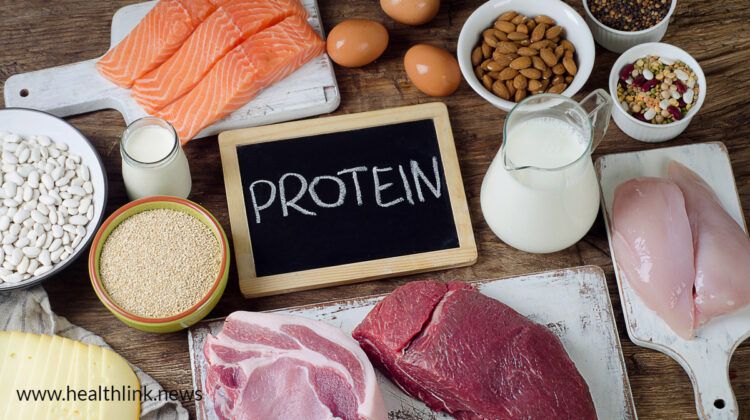Top 16 Protein-Rich Foods You Can Eat Every Day

Protein is a necessary part of every cell in your body. It gives structure and support to your cells, provides strength and endurance to your muscles, promotes firm skin and normal hair growth, assists with the production of hormones, enzymes, and antibodies, contributes to immune function, and helps you recover from illness or injury sooner. Protein is made up of tiny building blocks called amino acids. Nine of these essential amino acids cannot be produced by your body and must come from protein-rich foods.
Protein is one of the three major nutrients that are often called “macronutrients.” Next to water and carbohydrates, protein is the third most important nutrient. It is needed for growth and development, heart health, strong muscles, and bones, a healthy immune system, effective digestion, and body function, and feeling satisfied and full. Protein-rich foods not only support your health – but they can also help you lose weight and keep it off by keeping you feeling full.
By now you know that protein is an essential nutrient, and it is important to include protein-rich foods in your diet if you are physically active. But what are good sources of high-quality protein? Here is a closer look at meat and seafood, legumes, nuts and seeds, dairy products (including milk, yogurt, and cheese), and eggs.
1. Milk
Dairy milk is a good source of high-quality protein, and it is high in vitamins and minerals, like calcium, phosphorus, and riboflavin (vitamin B2). Everyone needs a good source of protein, and milk packs in a lot of this nutrient. One cup (246 mL) of dairy milk provides 8.32 grams of protein. It is a complete protein — meaning it contains all the essential amino acids your body cannot produce on its own — and it also provides nutrition that supports bone health and workouts. You can choose from milk or milk alternatives, like soy milk or cashew milk, or start drinking lactose-free milk to get more protein in your diet.
2. Fish
For healthy eating, choose fish. Fish is a great source of protein and gives you important vitamins and minerals, such as iodine and vitamin B12. Fish is also high in omega-3 fats, which are linked to many health benefits for you like helping to lower your risk of heart disease and type 2 diabetes. All types of fish are high in protein. For example, half a salmon fillet (124 grams) provides 30.5 grams of protein, while a cod fillet (180 grams) provides 41 grams of protein.
Fish can be high in mercury because mercury levels tend to accumulate in large fish, as fish eat smaller fish. The amount of mercury in fish varies greatly depending on the type of fish you choose and where it comes from. Fish that live longer, like tuna and swordfish, may have higher concentrations of mercury than shorter living fish such as salmon.
3. Peanuts and Peanut butter
Peanuts are often thought of as nuts, but they are legumes. This plant-based protein is rich in vitamins and minerals. While peanuts are usually eaten as a snack, they also function as a nutritious protein source. A 1-ounce (28.35-gram) serving of peanuts contains 7.31 grams of protein, while 2 tablespoons (32 grams) of peanut butter provides 7.2 grams. Being high in fiber, peanuts, and peanut butter may also help you feel full and avoid overeating. Peanuts and peanut butter are also high in protein and fiber, which help keep you fuller for longer. Peanut butter may even help reduce blood sugar spikes after a meal.
4. Turkey Breast
Turkey breast is similar to chicken breast in many ways, but with a few key differences. Turkey breast is high in protein and therefore great at filling you up. It is often used as the basis for chicken salad recipes or added to soups and grain dishes to increase their protein content. A 3-ounce (85-gram) serving of turkey provides 25.6 grams of protein. It is also very low in fat and has a decent number of calories, making it good for people who are trying to lose weight. Unlike chicken breast, however, turkey contains a lot of sodium, so it is important not to overdo it if you are keeping track of your blood pressure level.
5. Shellfish
Try adding shellfish, including shrimp, oysters, clams, and scallops to your diet. They are high in protein and a great source of healthy fat. Clams and shrimp are both good sources of protein. A 3-ounce (85-gram) serving of cooked clams provides 21.8 grams of protein, while the same serving of shrimp provides 20.4 grams of protein. Shellfish also contain many vitamins and minerals, including selenium, zinc, vitamin B12, and iron. You can enjoy them in a variety of recipes, including salads, pasta, and stir-fries.
6. Eggs
Eggs are one of the healthiest foods on the planet and one of the best protein sources you can eat. One large egg (50 grams) provides 6.3 grams of protein. Whole eggs are good sources of selenium, vitamins B12 and A, choline, and many other nutrients. If you are concerned about eating too much cholesterol, keep in mind that most studies show that eating whole eggs helps protect against heart disease so, enjoy them.
7. Pumpkin seeds
Pumpkin seeds are tiny and flat. They are generally sold in snack packs, along with other nuts and seeds. There are a few ways you can use pumpkin seeds to boost your nutrition. Pumpkin seeds provide 8.8 grams of protein per serving (1/4 cup / 29.5 grams). They are also commonly used as a garnish. Try adding them to salads, baked goods, oatmeal, and yogurt, or mix them with unsweetened dried fruit, and almonds for a convenient snack. Pumpkin seeds are high in plant-based protein and fiber. They also contain iron, phosphorus, and zinc.
8. Quinoa
Quinoa has grown in popularity around the world as a gluten-free source of protein. One cup (185 grams) of cooked quinoa provides 8 grams of protein. As a seed, it is categorized as a pseudo-cereal and is high in fiber, folate, copper, iron, and zinc. Quinoa is often referred to as a complete protein because it contains all nine of the essential amino acids that your body cannot make on its own. However, it contains insufficient amounts of certain amino acids, like lysine. For this reason, experts argue that quinoa should be considered a “nearly complete” protein. Regardless, quinoa is a good source of protein and is delicious baked into breakfast biscuits or mixed into other dishes like grain bowls and soups.
9. Almonds
Almonds are a healthy source of plant-based protein, fiber, and several important nutrients—like manganese, magnesium, and vitamin E. High protein nuts include almonds and pistachios. Almonds provide 6 grams of protein per ounce, while pistachios deliver 5.73 grams per 1-ounce serving. A 1-ounce (28.35 gram) serving of cashews provides 4.34 grams of protein. Eating almonds may benefit your health in several ways, including lowering heart disease risk factors like high LDL (bad) cholesterol and high blood pressure. To add more nuts to your diet, try pistachios or cashews.
10. Protein powders
When you are short on time and no meal will do, protein powders are an excellent option. You can easily add protein powders to shakes, smoothies, energy balls, yogurt, fat-free pudding, and other foods. There is a protein powder out there for nearly every taste preference and eating style! Whey protein powder provides about 16.6 grams of protein per scoop (28.6 grams), while pea protein provides 15 grams of protein per scoop (20 grams).
11. Lean beef
Eating lean beef is a good way to improve your protein intake. A 3-ounce (85-gram) serving of lean beef provides 24.6 grams of protein. It is also high in nutrients like iron, zinc, selenium, and vitamins B12 and B6. However, eating too much red meat has been associated with an increased risk of developing certain conditions. Try cutting back on red meat or replacing it with another source of protein, such as fish or poultry.
12. Ezekiel Bread
Ezekiel bread is made using organic and sprouted whole grains and legumes, including millet, barley, spelt, wheat, soybeans, and lentils. It is high in protein, fiber, and various important nutrients like iron and B vitamins. One slice (60 grams) of Ezekiel bread provides 6 grams of protein. Try making a protein-rich sandwich by topping Ezekiel bread with turkey, lettuce, tomato, and hummus.
13. Lentils
Lentils are an excellent source of plant-based protein, 100 grams (about 1/2 cup) of cooked lentils provides 9.02 grams of protein. Other high protein legumes include chickpeas, which provide 7.05 grams of protein per 100 grams cooked, and black beans, which provide 8.86 grams of protein 100 grams cooked and are loaded with nutrients like fiber, folate, magnesium, potassium, iron, copper, and manganese. Lentils, beans, and peas all offer more protein per serving than meat. Green and yellow lentils are rich in healthy plant-based protein. They have a less starchy and more peppery taste than brown or red lentils, which makes them ideal for use in salads and other dishes where they can add flavor apart from the meat.
14. Cottage cheese
Are you looking for a quick snack that does not need refrigeration and still provides protein? Cottage cheese can fill this role. Made from cow’s milk, cottage cheese is an excellent source of protein that is low in calories. Cottage cheese is a good source of protein. One cup of cottage cheese contains 28 grams of protein. Cheddar cheese is another source of protein. There are 3.96 grams of protein in one 17-gram slice of cheddar cheese, and 6.29 grams if you eat an ounce (28.35 grams) of mozzarella cheese. Because it is very rich in calcium, phosphorus, selenium, vitamin B12, riboflavin (vitamin B2), and various other nutrients, your body uses the protein in cottage cheese as part of its daily functioning systems.
15. Greek yogurt
Not a fan of eating so much meat and dairy product? Opt for eating super thick Greek yogurt with a creamy texture and a tart flavor, it is comparable to sour cream or creme Fraiche. If you are looking for a good source of protein, Greek yogurt is the product for you. Full of nutrients such as calcium, vitamin B12, vitamin A, selenium, and zinc and packed with protein, this kitchen staple is a must-have in every pantry. One 7-ounce (200-gram) container provides 19.9 grams. Other yoghurt products that are high in protein include unsweetened low-fat yogurt, which provides 11.9 grams of protein per 8-ounce (227-gram) container, and kefir, which provides 9.21 grams of protein per 1 cup (243 mL). Incorporate Greek yogurt into soups, salads, vegetables, or baked goods to bring protein and extra flavour to your meals. A little bit goes a long way—add it gradually at first to ensure the taste is not too overpowering.
16. Chicken breast
Chicken breast is a protein food that provides an excellent nutrient profile. It is made up of high‐quality protein, along with vitamin B and minerals that support a healthy body. It is good for your health and essential for healthy life. If you are trying to build up your protein intake, chicken breast is a good alternative to sources like red meat. A half-breast of chicken will provide you with 26.7 grams of protein.
